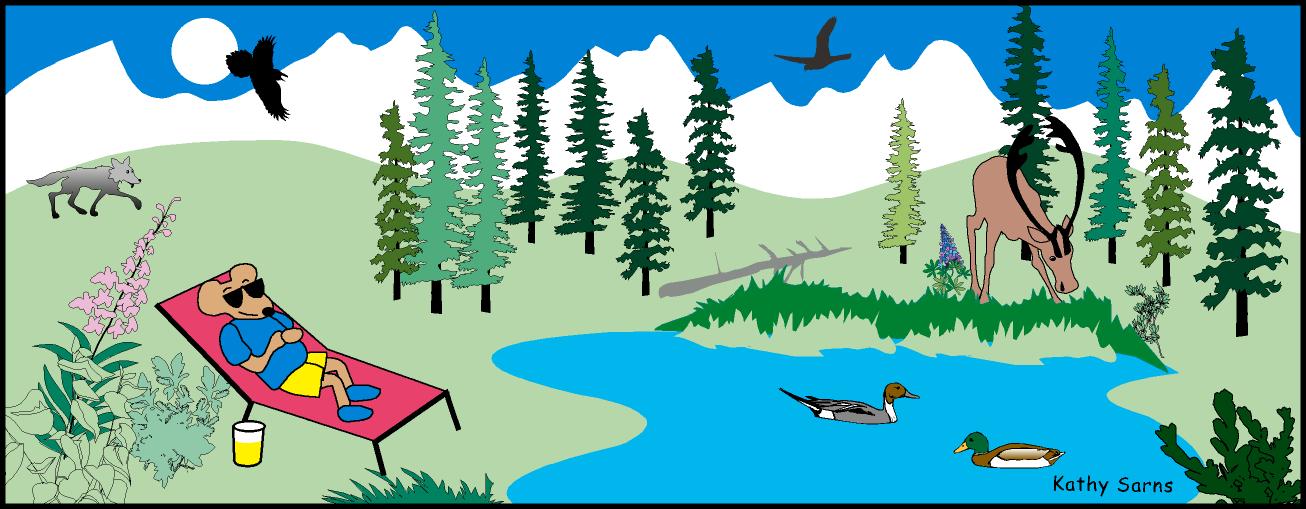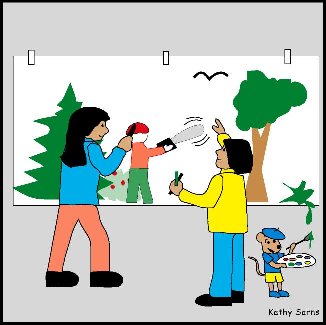
|
 |

| Grade Level: 2-6 |
| Alaska State Content Standards: SA14, SA15, GeoE4, GEOE5,GovG3 |
| Subject: Science, Geography, Government |
| Skills: Analysis, Comparison, Description, Generalization, Problem-Solving |
| Duration: 2 class periods |
| Group Size: 2 |
| Setting: outdoors |
OBJECTIVE
Students describe different uses and their effects on the ecosystem.
TEACHING STRATEGY
Students construct a mural to show the effects of different human activities on the environment.
MATERIALS
Paper and pencil
Large white butcher paper
Construction paper
TEACHER BACKGROUND
The different ecosystems of Alaska are important to people economically and aesthetically. Although people use wood to heat and build homes, only 1/5 of the interior boreal forest has commercial
value. Some of this wood may be gathered from the streams or the ocean. Plants are gathered for food and animals are harvested for fur. Recreationalists enjoy the aesthetically pleasing settings that a variety of ecosystems provide. Sometimes human activities can be detrimental if the resources and activities are mismanaged.
Each ecosystem provides important habitat for wildlife of many kinds. From small invertebrates to large mammals and birds, these areas provide the food, water, shelter, and space wildlife needs to thrive.
In Alaska one of the most common natural forces that changes natural systems is lightning caused fire. Scientists now understand the beneficial effect fires have on habitat and wildlife. Fire removes dead brush and trees, creates new browse for animals, and diversifies habitat, in turn, attracting a greater diversity of animals.
All ecosystems have renewable resources that are affected by natural and human forces. Resource management acknowledges these forces and strives to maintain healthy and productive ecosystems.
PROCEDURE

- Students will construct a large mural on a bulletin board or wall. Younger students may want to use a felt board. Make a list of tasks that must be accomplished to complete the mural and assign these tasks to student groups. Using construction paper, have some students cut out trees, streams, other plants, and wildlife (these can be taped to the mural). Other students can draw and color features like the sun, sky, and water directly onto the mural.
- Brainstorm with students the activities of different resource users (loggers, miners, homesteaders, land developers, hunters, trappers, berry pickers, photographers, etc.). Try to think of one for each two students in the class. Write each on a piece of paper, fold it up, and place them all in a box or bag.
- Divide the class into pairs and have each pair draw a paper from the box. Allow the students time to discuss how their resource user would affect the forest. Although students may stereotype users, it is important to point out that people are individuals and that not all users of one type will act in the same manner.
- Each pair presents to the class how the actions of their resource user would affect the ecosystem. Students use the mural to illustrate their presentation and may remove ecosystem components (trees, wildlife, etc.) from the mural. If the ecosystem becomes depleted of resources after several presentations, have the class discuss why this happened. You may need to reassemble the mural to complete the presentations. After all the presentations have been made, ask the students if there are unlimited resources for us to use.
- The teacher selects 3 users and asks the class to discuss how these three might work together to use the same ecosystem without destroying it. Conclude the activity by discussing the fact that the public owns most of Alaska’s lands.
VALUATION
Have students pretend that he/she is a land manager. Have them write about how they would manage the land that has all the users brainstormed in the activity.
EXTENSIONS
Invite a local land manager to the class to talk about fire management.
| Printable version | Add to favorites | Make Alaska FWS my homepage |
| Site designed and maintained jointly by the USFWS Alaska Region Division of Information Resource Management (IRM) and External Affairs (EA). |